More From the Los Angeles Times
Most Read in Business
-
-
-
-
Nov. 11, 2024
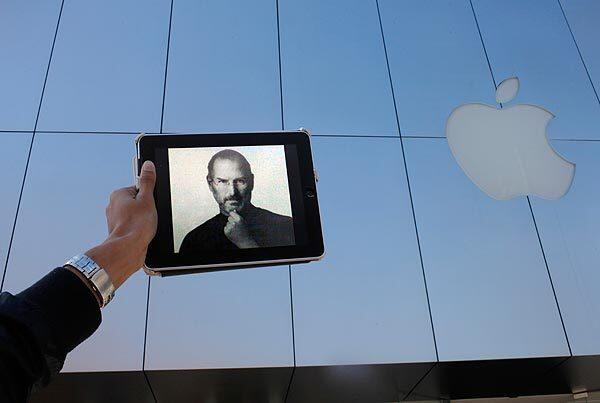
At the Apple store in Santa Monica, a man holds an
Apple co-founder Steve Jobs’ legacy of blockbuster products includes the Macintosh, iPod, iPhone and iPad.Full coverage: The death of Steve Jobs
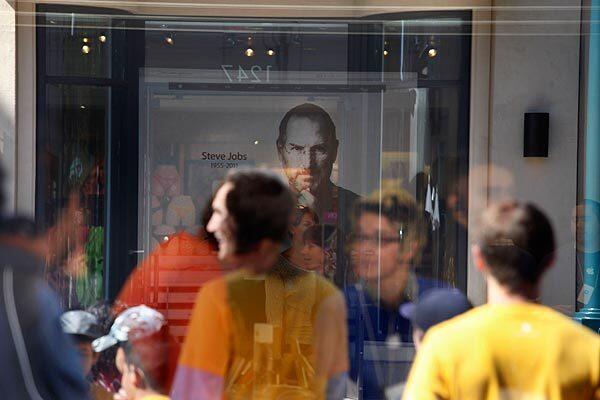
A photo of
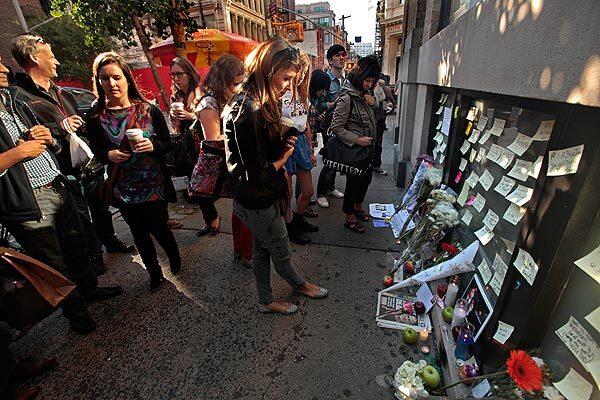
People gather at the Apple store in
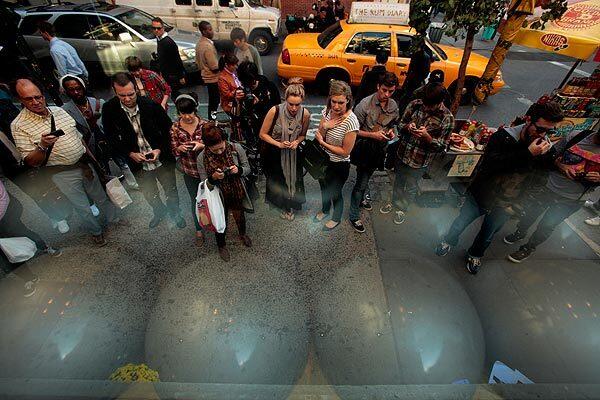
People look at the tributes to
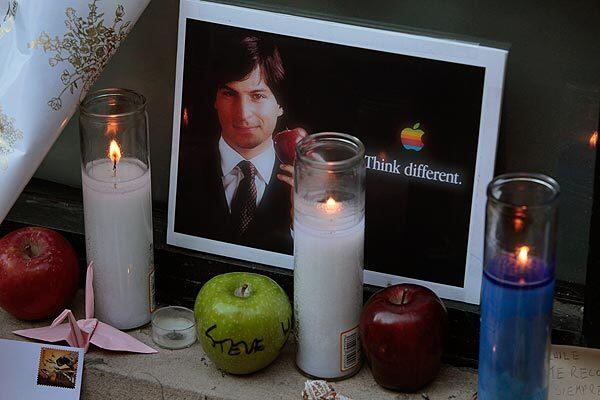
Tributes to
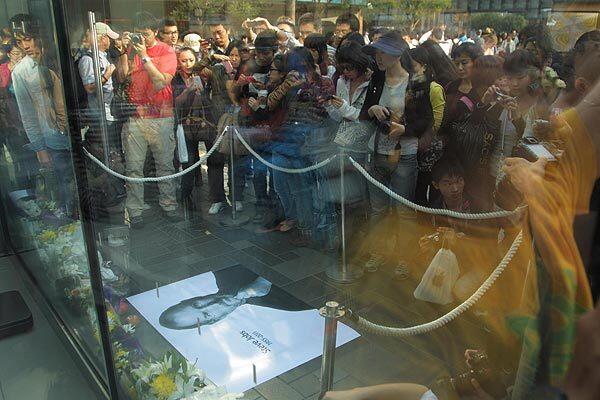
People mourn Apple co-founder
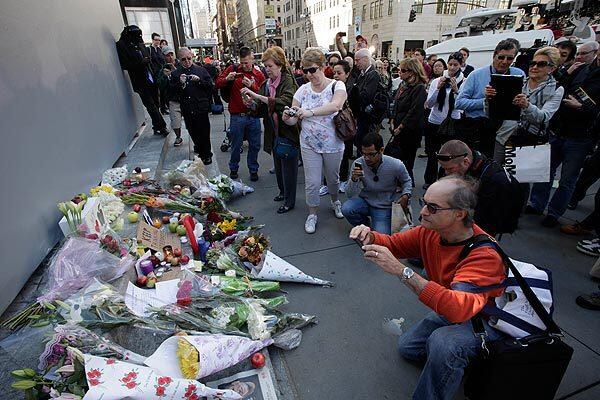
Passersby photograph a memorial for Apple co-founder

Unidentified women embrace before they enter
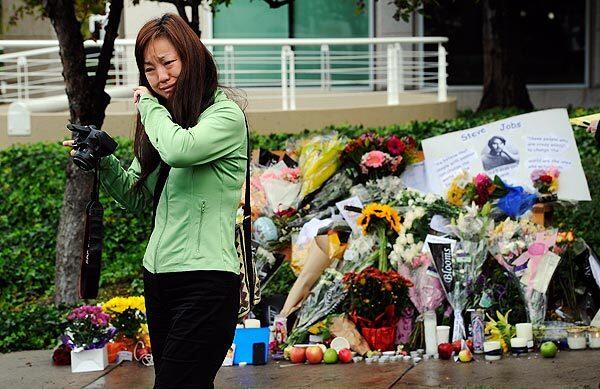
Christine Gng, the wife of an Apple employee, cries Wednesday after taking a picture of the makeshift memorial for

A memorial to
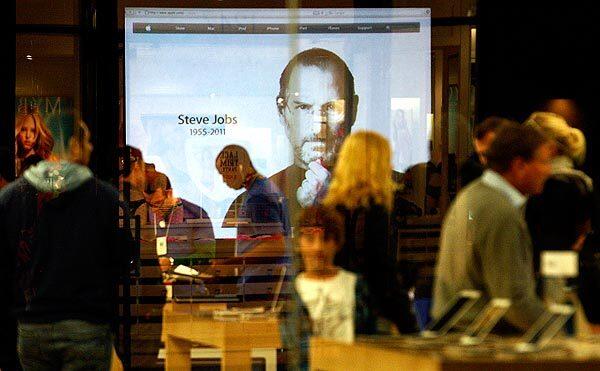
An image of
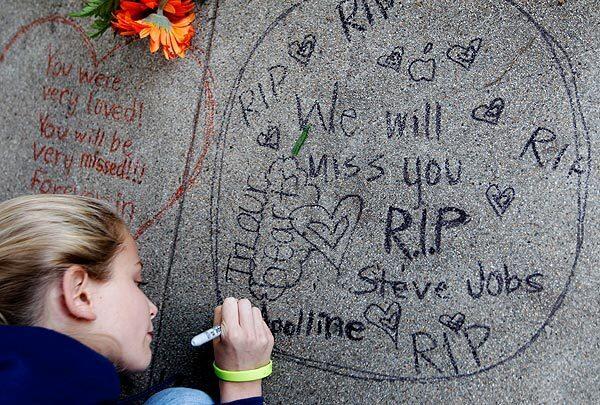
Apolline Arnaud, 12, a neighbor of Apple co-founder
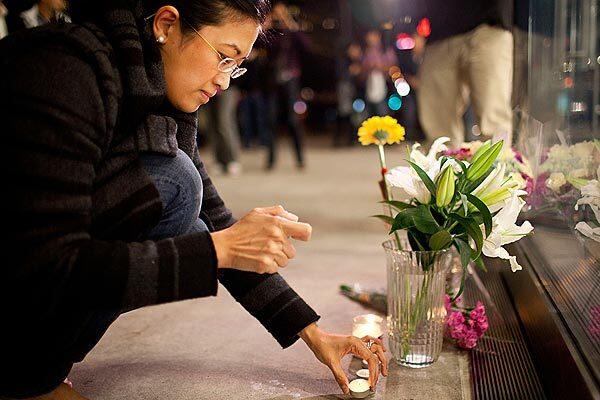
Surina Shukri lights a candle in remembrance of
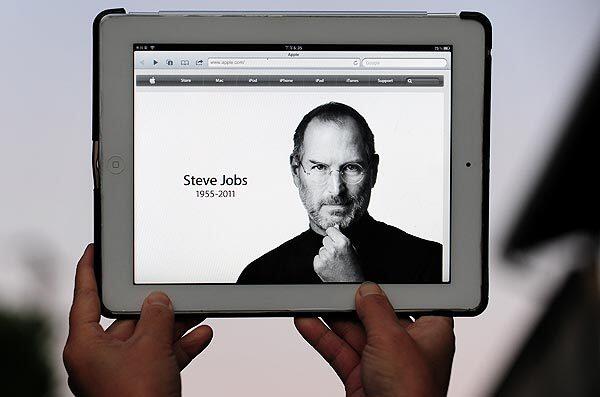
The Apple website’s home page, paying homage to
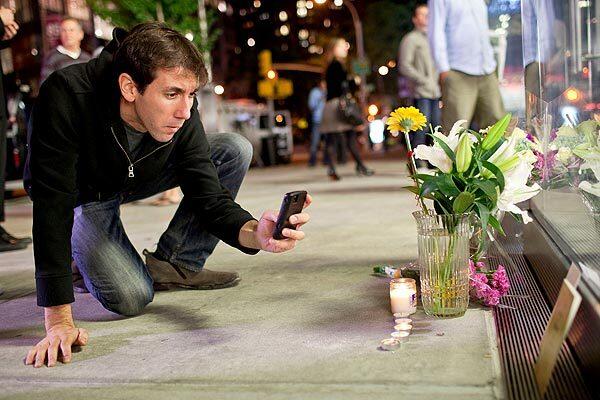
Aaron Katersky takes a picture of candles and flowers that have been placed in remembrance of
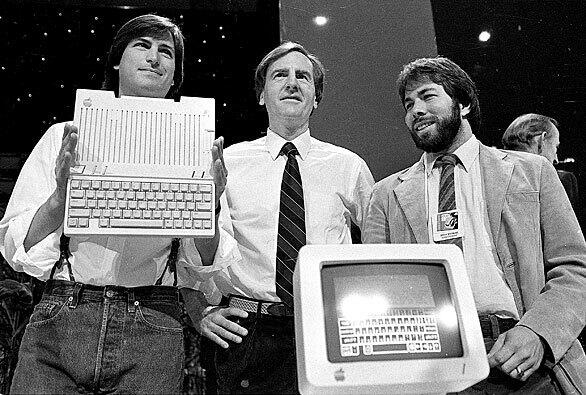
Jobs, left, unveils the Apple IIc computer with Apple Chief Executive John Sculley and co-founder Steve Wozniak. Jobs and Wozniak met when Jobs was in high school in Cupertino, Calif., and Wozniak was intermittently attending college. The two partnered up to make and sell machines that let users make free international phone calls. In 1976, they founded Apple in a Los Altos, Calif., garage. (Sal Veder / Associated Press)
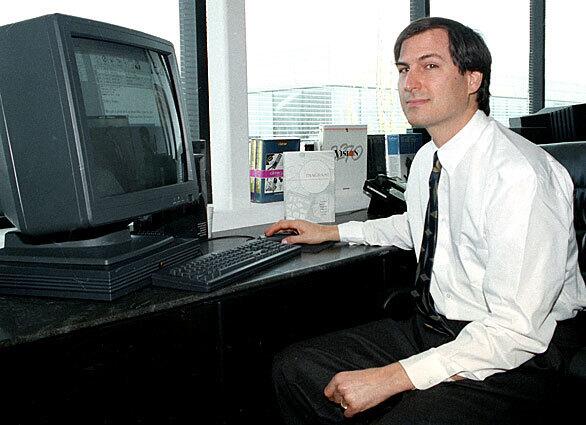
Jobs shows off his NeXTstation color computer at his company’s Redwood City, Calif., facility in 1991. The same year, he and his wife, Laurene Powell, were married at Yosemite National Park by a Buddhist monk. (Ben Margot / Associated Press)
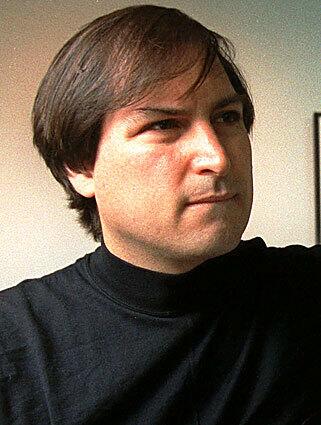
Jobs announced in 1993 that Next would stop building computers and focus on its software. “The world doesn’t want really great hardware, it wants really cheap hardware,” he said. “I can’t really argue with that. (Kristy MacDonald / Associated Press)
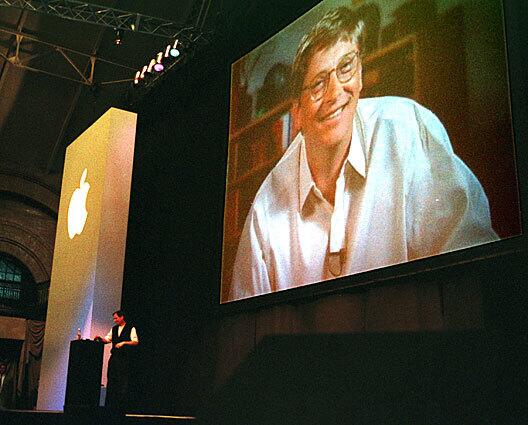
The industry was shocked when Jobs announced that the struggling Apple had forged an alliance with its sworn enemy, Microsoft. At the 1997 Macworld Expo trade show, Microsoft Chief Executive Bill Gates chimes in via satellite. (Julia Malakie / Associated Press)
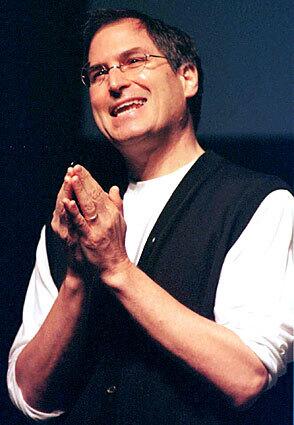
Jobs also announced that week that he had joined Apple’s board of directors. (John Mottern / AFP/Getty Images)
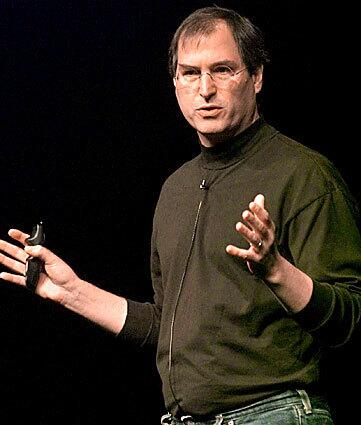
Jobs, as Apple’s interim chief executive, gives his keynote address to the Publishing 98 trade show in New York. He introduces an under-$2,000, 15-inch flat-screen monitor, among other products. (Richard Drew / Associated Press)
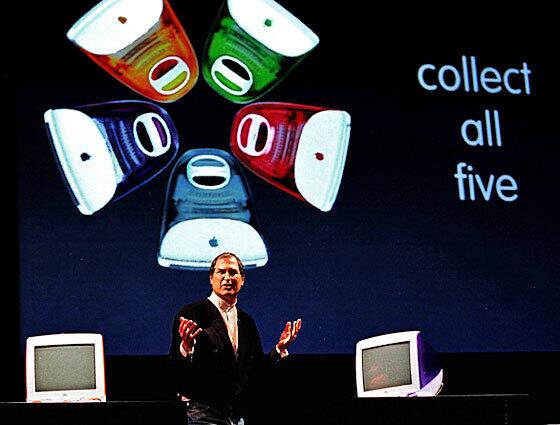
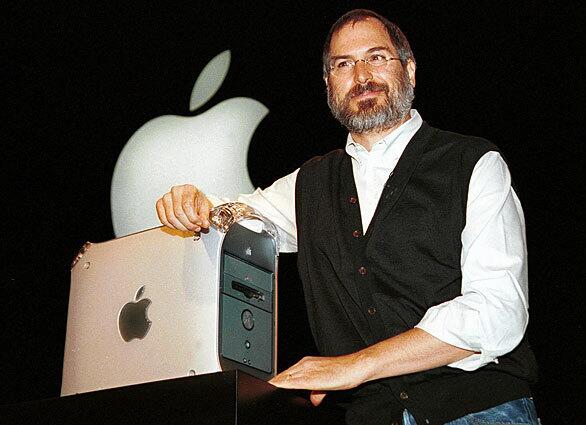
Jobs introduces the Power Mac G4 computer during his keynote address at Seybold in San Francisco. He presented it as the fastest personal computer in history, saying it was up to 200% faster than the fastest Pentium III-based PCs. (John G. Mabanglo / AFP/Getty Images)
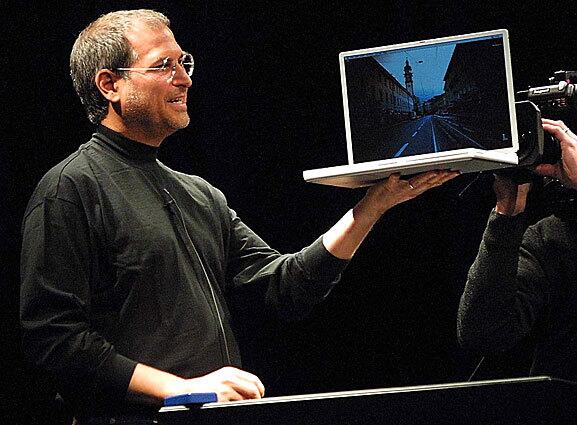
Jobs unveils a new titanium G4 Powerbook with a 15.2-inch screen at the 2000 MacWorld Expo in San Francisco. He also announced new configurations of the G4 desktop Macs as well as new audio and DVD software. (John G. Mabanglo / AFP/Getty Images)
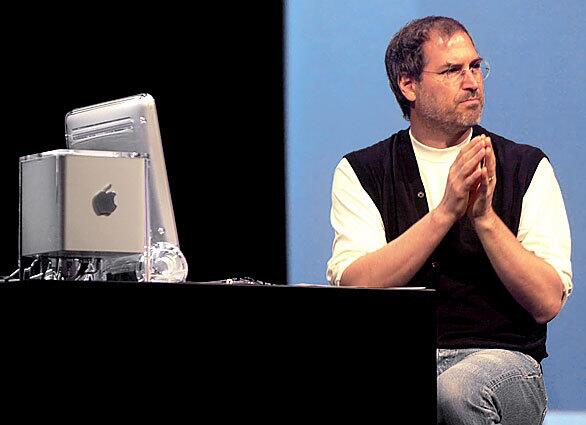
Jobs demonstrates Apple’s new flat screen and G4 Cube at the Seybold Conference & Exposition. He also announced the upcoming launch of the OSX operating system. (Paul Sakuma / Associated Press)
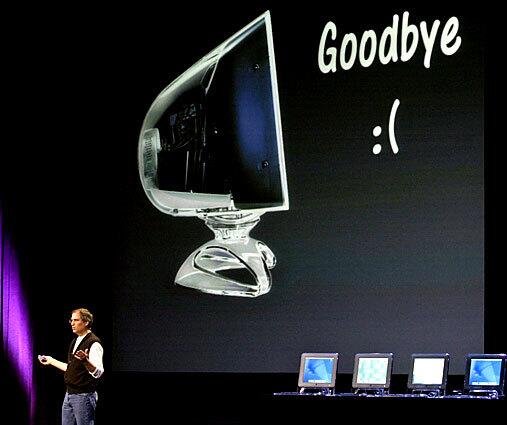
Apple will stop producing cathode ray tube displays, Jobs announces during the Apple Developers Conference in San Jose. He said Apple would be the first major computer company to produce all LCD displays. (Paul Sakuma / Associated Press)
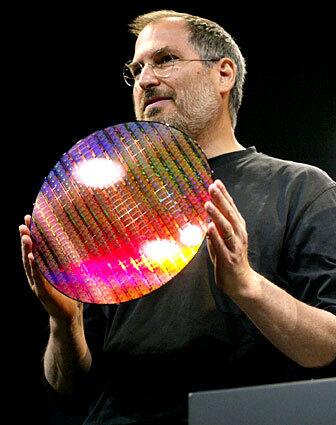
Apple Computer Inc. chief executive Steve Jobs holds the new IBM processor used by the new Apple G5 computer at the Apple Worldwide Developers Conference in San Francisco, Monday, June 23, 2003. Jobs gave the keynote speech that introduced OS X operating system, code-name Panther. (Susan Ragan / Associated Press)
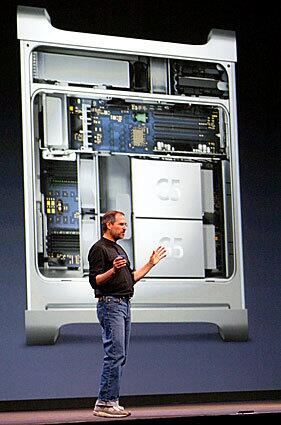
Steve Jobs delivers the keynote address at the Worldwide Developers Conference in San Francisco, announcing the new Power Mac G5 desktop computer. (Justin Sullivan / Getty Images)
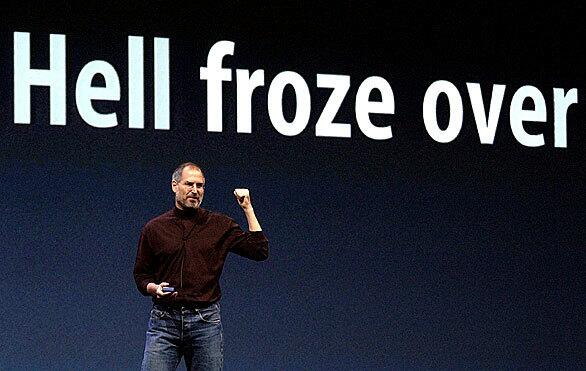
Broadening the reach of the iTunes music store, Jobs announces a Microsoft Windows-compatible version of the popular Internet song-downloading service, which was previously available only on Macintosh operating systems. Compatibility with Windows “is a feature a lot of people thought we’d never have until ... hell froze over,” Jobs said. (Ben Margot / Associated Press)
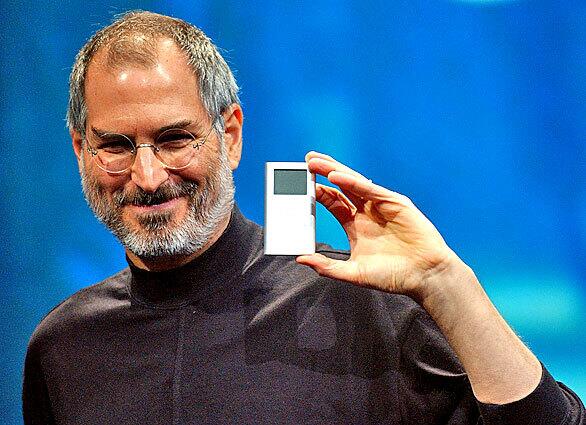
Jobs displays the new iPod Mini at the 2004 Macworld Conference and Expo in San Francisco. (Marcio Jose Sanchez / Associated Press)
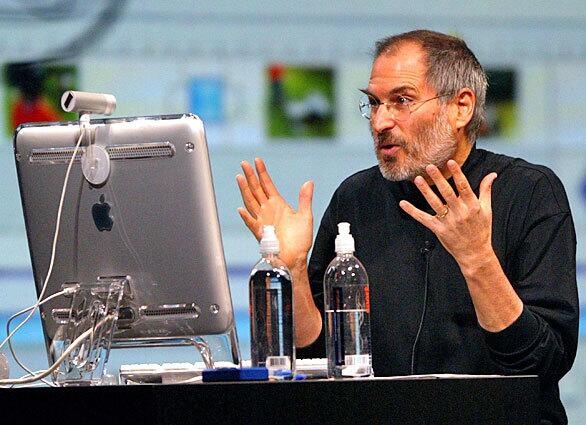
Jobs gestures as he delivers a keynote address at the 2004 MacWorld conference. Jobs announced several new products including the new iLife 4 software and the
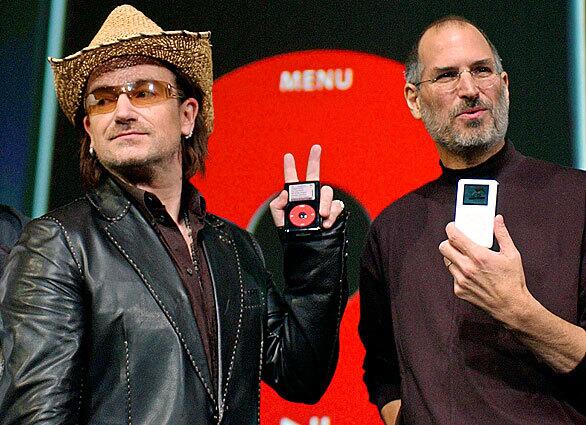
Bono, of the band U2, and Jobs hold up iPods at an unveiling of a new branded iPod in San Jose. (Paul Sakuma / Associated Press)
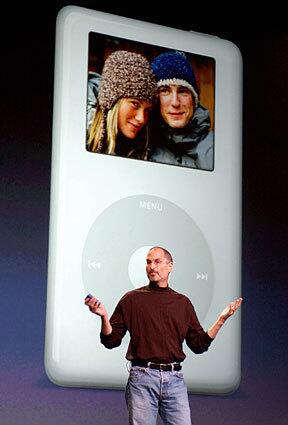
Jobs introduces the iPod Photo, which has a color screen to display photos and slide shows accompanied by music. The 60-gigabyte model could hold 25,000 photos and sold for $599; a 40-gigabyte model sold for $499. (Paul Sakuma / Associated Press)
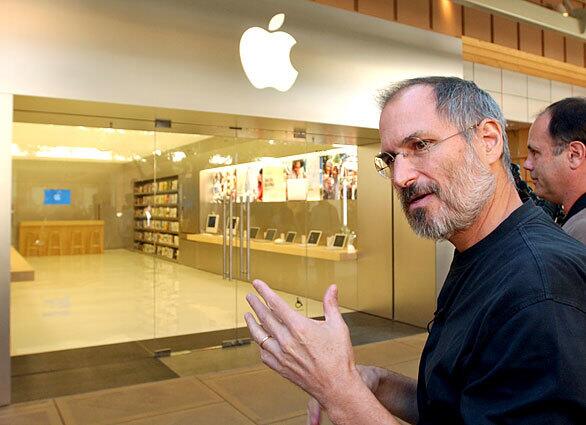
Jobs unveils the first Apple mini-store, in Palo Alto, Calif. The press conference was his first public appearance since he underwent surgery for cancer that July. Jobs, then 49, had taken a month-long leave to recuperate and quietly returned to work full time in September. (Paul Sakuma / Associated Press)
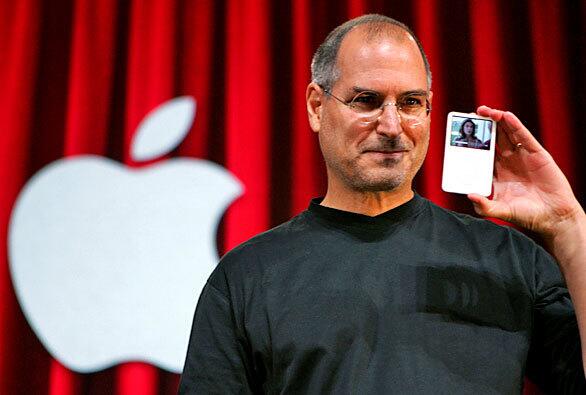
Jobs holds up the new iPod, showing an episode of hit television show “Desperate Housewives.” Apple Computer Inc.’s momentum in 2005 seemed unstoppable as it launched one hit product after another: the iPod Shuffle, the Mac Mini, the iPod Nano, a video-playing iPod and TV shows for sale on its iTunes store. (Paul Sakuma / Associated Press)
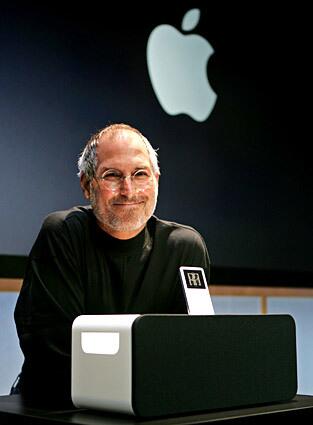
Jobs introduces a speaker system for iPods. (Paul Sakuma / Associated Press)
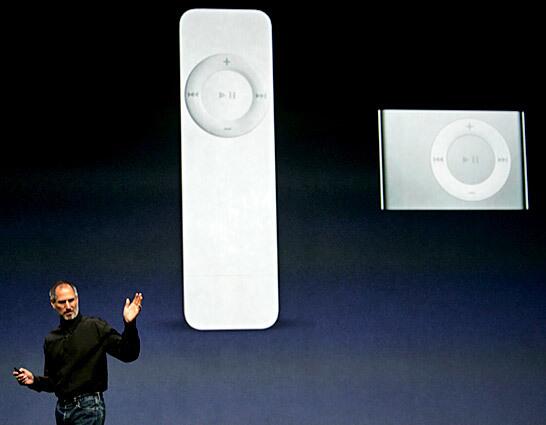
Jobs announces a new iPod Shuffle, right, and compares it to the the older Shuffle, left. He also announced a new iPod nano with a 24-hour battery life and new games for the portable media player. (Paul Sakuma / Associated Press)
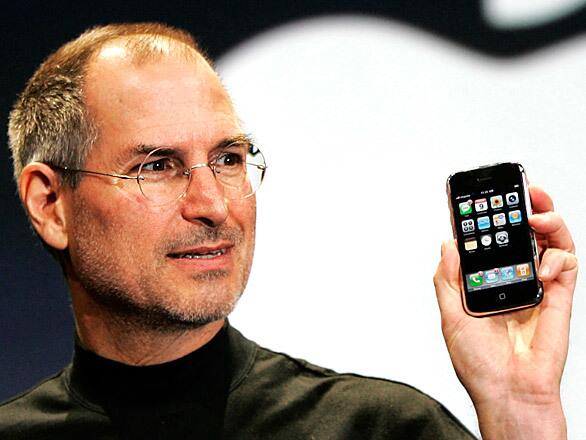
Jobs demonstrates the new iPhone, a gadget with the capabilities of both an iPod and a cellphone, at the 2007 MacWorld conference. (Paul Sakuma / Associated Press)
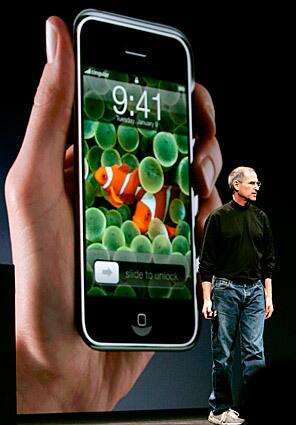
Consumers were excited about the much-hyped launch of the iPhone, focusing on its cool looks and innovative interface. The iPhone broke several cellphone-industry conventions about the relationships between handset manufacturers, carriers and consumers. (Paul Sakuma / Associated Press)
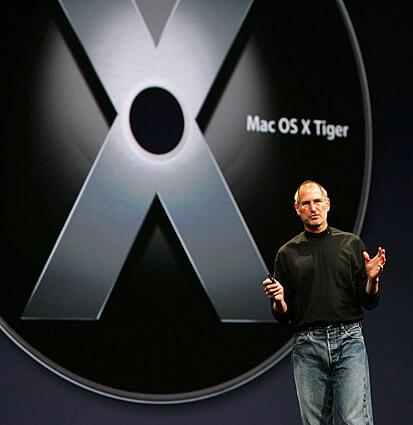
Jobs gives the keynote address on the opening day of the
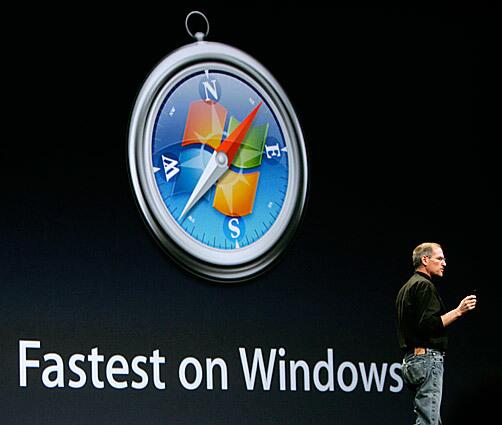
Jobs talks about Safari for Windows at the Apple World Wide Developers Conference. (Paul Sakuma / Associated Press)
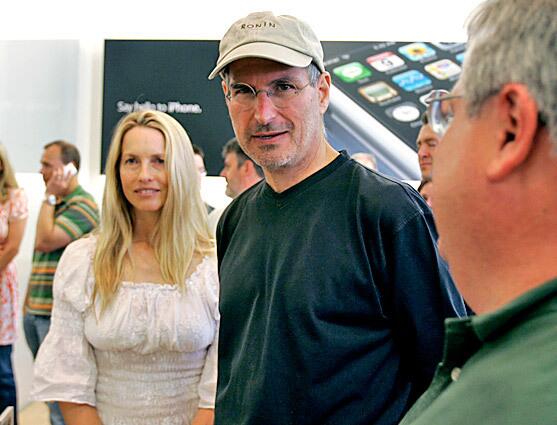
Jobs and his wife, Laurene Powell, meet with customers after the launch of the
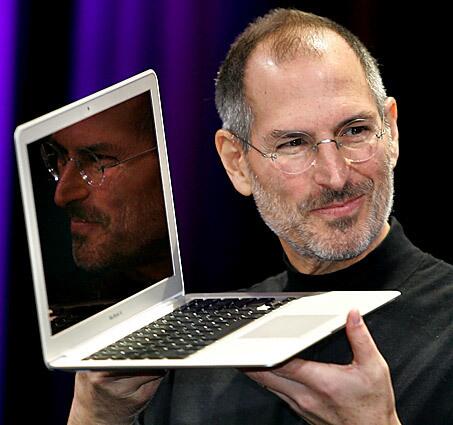
Jobs shows off the new Macbook Air, a small, light laptop, during his keynote speech at the 2008 MacWorld conference in San Francisco. Almost exactly one year later, Jobs announced that he would take a medical leave of absence from Apple through June, saying his health issues were “more complex than I originally thought.” (Tony Avelar / AFP/Getty Images)
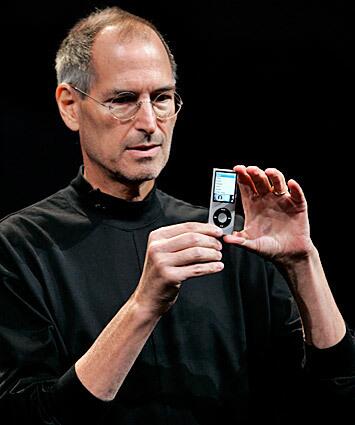
Shares of Apple Inc. fell 4% on Jan. 15, 2009, as investors struggled to parse Jobs’ announcement about his health. In an e-mail to employees, Jobs had said he would take the leave of absence “in order to take myself out of the limelight and focus on my health, and to allow everyone at Apple to focus on delivering extraordinary products.” (Paul Sakuma / Associated Press)
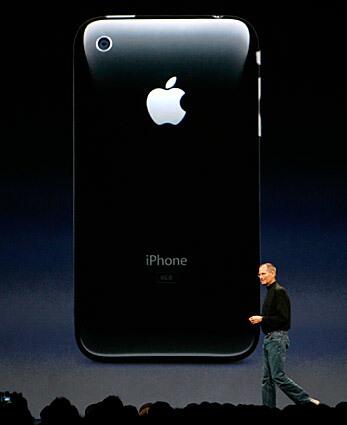
Jobs announces the new iPhone 3G during the keynote speech at the 2008 Apple Worldwide Developers Conference in San Francisco. He also announced innovations to the Mac OS X Leopard operating system. (Eric Risberg / Associated Press)
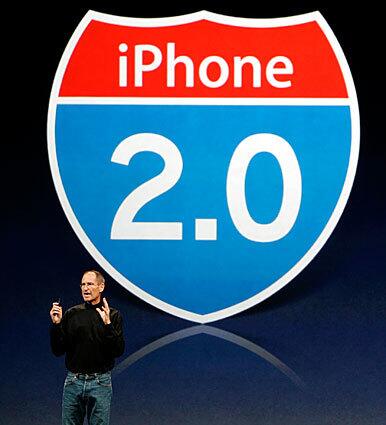
Jobs delivers the keynote speech during the Apple Worldwide Developers Conference in San Francisco. (Eric Risberg / Associated Press)
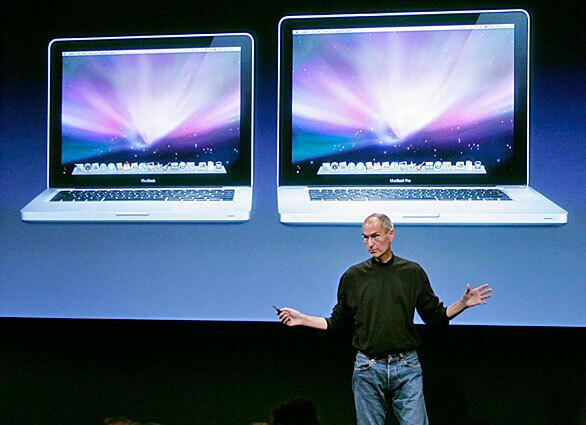
Jobs introduces new versions of the MacBook, left, and MacBook Pro at Apple headquarters in Cupertino, Calif. (Paul Sakuma / Associated Press)
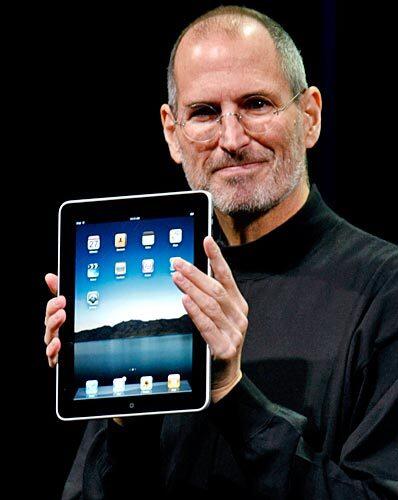
Jobs holds up the iPad, a portable device for reading books, watching video and surfing the Web, at its unveiling in San Francisco. “We think we’ve got the goods. We think we have done it,” he said. (Paul Sakuma / Associated Press)
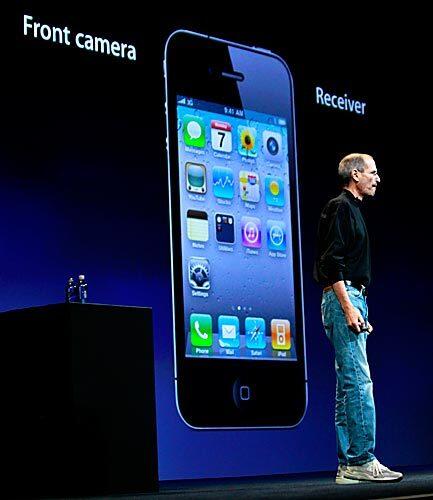
Jobs introduces the iPhone 4 at the Apple Worldwide Developers Conference. “I grew up with ‘The Jetsons’ and ‘Star Trek,’ just dreaming about video calls,” Jobs told the audience. “And it’s real now.” (Paul Sakuma / Associated Press)
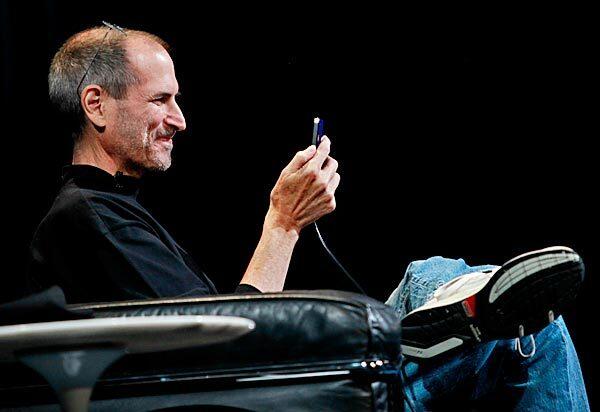
“This is the biggest leap we’ve taken since the original iPhone,” Jobs said of the iPhone 4 as he introduced it at the Apple Worldwide Developers Conference, (Paul Sakuma / Associated Press)
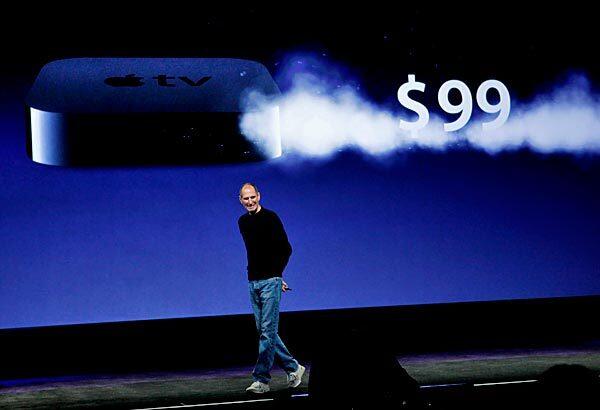
Jobs announces the $99 Apple TV device, with 99-cent online TV show rentals. The majority of Hollywood studios, and two broadcast networks -- CBS and NBC -- declined to allow their shows to be included. “Not all of them wanted to take this step with us,” Jobs said. “We think the other studios will see the light.” (Paul Sakuma / Associated Press)
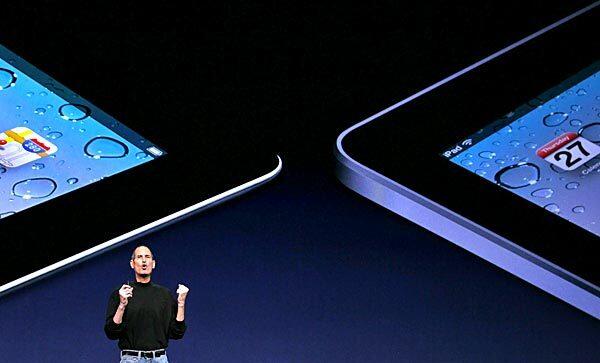
In his trademark black mock turtleneck, Jobs touts the new iPad 2. Apple had sold more than 15 million of the original version since its introduction in January 2010, and analysts expected the device to account for more than 80% of tablet sales in 2011. (Justin Sullivan / Getty Images)
Nov. 11, 2024